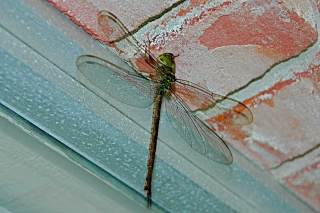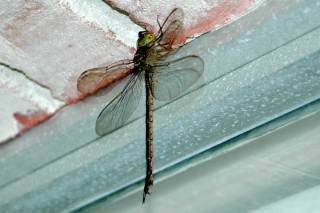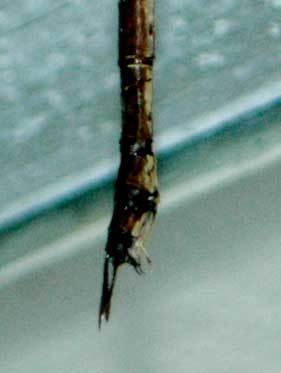A two-year-old mystery has come closer to being solved, thanks to the friendly folks at bugguide.net. You see, back when Tropical Storm Fay blew into town on August 18, 2008, a large dragonfly took shelter on our porch:
It is long and slender-bodied, almost like a knitting or darning needle. I can recall that it was quite large; I don’t think I’d ever seen such a large dragonfly so close before. The eyes are huge; see how there’s no “top of the head” on this guy? There’s eyes, and nothing else. And as you can see, it was hanging vertically from the brick face surrounding the giant picture window that I was in the process of covering with hurricane shutters at the time.
All of these traits (except for the hurricane shutters, of course) point to this dragonfly being one of the eight darner species (family Aeshnidae) in Florida. Here is Dunkle’s description of the family:
The darners are long and slender-bodied, like a darning needle, and they include the largest Florida Dragonflies. Their eyes are very large and meet in a seam on top of the head. In most species scars can be seen on the eyes of a female where a male has held her during mating. Females have an ovipositor with blades, as in the Petaltails. Darners hang vertically on a perch whether it is a vertical stem or a horizontal twig [or in this case a brick-face wall]” (20).
Unfortunately I wasn’t aware of the importance of the thorax in distinguishing among several possible species in different genera, Comet Darner (Anax longipes), Cyrano Darner (Nasiaeschna pentacantha), and Regal Darner (Coryphaeschna ingens), but I’m pretty sure that this is the latter species. [UPDATE 9/10/10: Upon further review, it looks like Twilight Darner (Gynacantha nervosa) is a better match for this individual. The thoracic markings are indistinct, which fits G. nervosa much better than C. ingens.] In the first place, the friendly folks at bugguide.net think it’s likely to be. In the second place, most of the photos I’ve seen of Comet Darners show “blotches” on the abdomen, rather than the “dots” I see on this one. Cyrano darner has those dots, but, according to the checklist from Odonata Central, has not been recorded in Palm Beach County, while Regal Darner has been. (Not that going by the book is a sure guide, particularly with a tropical storm that could be blowing things in from far away, but it’s another piece of the puzzle.)
Now, two years later, I sure wish I’d taken more photos, but at the time I was more concerned with putting the hurricane shutters on than I was with narrowing down the ID of the animal. I was pretty sure the photos I had would be conclusive. As it turns out, they are simply not good, from any angle, because I didn’t know what I should have been looking for. That’s why relying on photography for a positive ID is a problem: if the field mark you need is not in focus, you’re out of luck. (On the flip side, it’s a good learning tool: now I know to try to get good pictures of the thorax for any darner, so we can use the markings there to help figure out what it might be.)
Here’s the other side, of the animal, with a better view of the tail:
In this view, it’s a bit easier to see the ovipositor:
Those two strips hanging down from the very end of the tail, on the left of the picture (top, or dorsal side)? That’s not the ovipositor; those are called cerci, or terminal abdominal appendages, and both sexes have them. On a good picture of this insect, like this one, you can see that they are quite long; the ones on this lady are pretty short. No, the ovipositor is a bit higher up, on the right of the picture (ventral, or bottom, side of the abdomen). [UPDATE 9/10/10: the ovipositor is above the last abdominal segment, 10; on that segment (S10), you can see, in Dunkle’s words and in that photo of the tail, “2 spines on the underside…which are used during egg deposition. [They] form a fulcrum when she uses her ovipositor blades to lay eggs in soil” (28).] So don’t get confused if you see a male dragonfly with terminal appendages. That’s perfectly normal. A male dragonfly with an ovipositor, though—that would be big news.
So, to make a long story short, if you want to take better nature photos, learn more about your subjects, so you can know what it is you’re trying to capture. Then see if there’s a way to make it pretty. I have a long way to go on both fronts… But it’s a fun road to travel!



